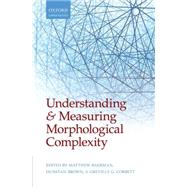Understanding and Measuring Morphological Complexity
, by Baerman, Matthew; Brown, Dunstan; Corbett, Greville G.- ISBN: 9780198723769 | 0198723768
- Cover: Hardcover
- Copyright: 5/26/2015
Matthew Baerman, Research Fellow, Surrey Morphology Group, University of Surrey,Dunstan Brown, Professor of Linguistics, University of York,Greville G. Corbett, Distinguished Professor of Linguistics, University of Surrey
Matthew Baerman is a research fellow in the Surrey Morphology Group at the University of Surrey. His research focuses on the typology, diachrony and formal analysis of inflectional systems, with a particular concentration on phenomena whose interpretation is problematic or controversial. His work has appeared in such journals as Language, Journal of Linguistics, Morphology, Lingua, and Natural Language and Linguistic Theory. He is the editor of OUP's forthcoming Oxford Handbook of Inflection. Matthew Baerman, Dunstan Brown, and Greville G. Corbett are joint authors of The Syntax-Morphology Interface: A Study of Syncretism (CUP 2005).
Dunstan Brown holds an Anniversary Chair in the Department of Language and Linguistic Science, University of York. His research interests include autonomous morphology, morphology-syntax interaction and typology. Much of his work focuses on understanding morphological complexity, such as syncretism and computational modelling of morphological systems. His publications include Network Morphology (with Andrew Hippisley; CUP 2012) and Canonical Morphology and Syntax (co-edited with Marina Chumakina and Greville G. Corbett; OUP 2012).
Greville G. Corbett is Distinguished Professor of Linguistics at the University of Surrey, where he leads the Surrey Morphology Group. He works on the typology of features, as in Gender (1991), Number (2000), Agreement (2006), and Features (2012), all published by Cambridge University Press. His recent research has been within the canonical approach to typology and he is one of the originators of Network Morphology. He is co-editor, with Dunstan Brown and Marina Chumakina, of Canonical Morphology and Syntax (OUP 2012)
Part I What is Morphological Complexity?
1. Understanding and measuring morphological complexity: An introduction, Matthew Baerman, Dunstan Brown, and Greville G. Corbett
2. Dimensions of morphological complexity, Stephen Anderson
Part II Understanding Complexity
3. Abstract architectural properties of the morphomic analysis of Kayardild, Erich R. Round
4. Morphological opacity: Rules of referral in Kanum verbs, Mark Donohue
5. Oneida pronominal complexity: An upper-bound on morphological complexity?, Jean-Pierre Koenig and Karin Michelson
6. Gender-number marking in Archi: Small is complex, Marina Chumakina and Greville G. Corbett
Part III Measuring Complexity
7. Contrasting modes of representation for inflectional systems: Some implications for computing morphological complexity, Gregory Stump and Raphael A. Finkel
8. Computational complexity of abstractive morpholog, Vito Pirrelli, Marcello Ferro, and Claudia Marz
9. Patterns of syncretism and paradigm complexity: The case of Old and Middle Indic declen, Paolo Milizia
10. Learning and the complexity of O-marking, Sebastian Bank and Jochen Trommer
The New copy of this book will include any supplemental materials advertised. Please check the title of the book to determine if it should include any access cards, study guides, lab manuals, CDs, etc.
The Used, Rental and eBook copies of this book are not guaranteed to include any supplemental materials. Typically, only the book itself is included. This is true even if the title states it includes any access cards, study guides, lab manuals, CDs, etc.
Digital License
You are licensing a digital product for a set duration. Durations are set forth in the product description, with "Lifetime" typically meaning five (5) years of online access and permanent download to a supported device. All licenses are non-transferable.
More details can be found here.






